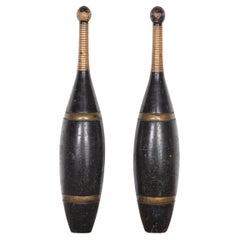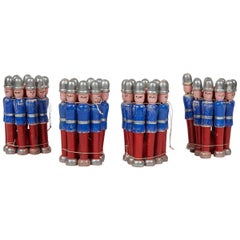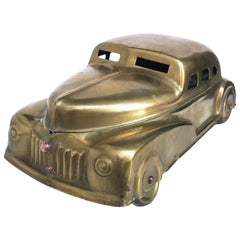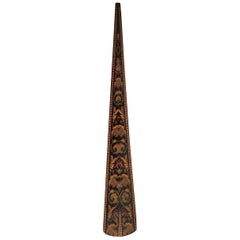Lee Stanton Antiques Games
to
2
2
1
1
1
1
2
2
2
2
2
2
2
Pair of 19th Century Juggler Pins
Located in Los Angeles, CA
These 19th-century English juggler’s pins, with their ebonized finish and slender, tapered form, carry a sense of mystery and history in their weathered appearance. Highlighted by go...
Category
Antique 1890s English Games
Materials
Wood
$2,475 / set
Carved and Painted Children's Toy Skittle Game Set from England, circa 1940
Located in Los Angeles, CA
Four sets of skittle pins painted to look like toy soldiers from 1940s England. The bright, cheery colors and elegant carving make these an especially char...
Category
Vintage 1940s English Games
Materials
Wood
Related Items
Betel Motor Car Art Deco Brass Box, Collectible Toy, Children's Paint Set, 1930s
Located in Roma, IT
Patent 75086 - This is a large tobacco box with many purposes, (Child's Paint Set). Car in multicolored golden tin in classic brass. Almost new with all the original parts. Wonderful...
Category
Early 20th Century American Art Deco Models and Miniatures
Materials
Metal, Brass
$1,427
H 3.94 in W 10.24 in D 4.73 in
Rare 19th Century English Tunbridgeware Hair Pin or Slide
Located in Dallas, TX
PRESENTING an EXTREMELY UNIQUE and RARE 19C British Tunbridgeware Hair Pin/Bobbin or Slide.
This slide is unlike any of it’s kind we have seen before, it is a VERY RARE survivor.
From circa 1860 – 80 and made in Tunbridge Wells, England.
Made of walnut with gorgeous marquetry inlay on the entirety of the front with classic Tunbridgeware micro-mosaic all over the front. The rear is walnut.
The marquetry inlay appears to be various different woods, namely, maple, walnut and satinwood.
Would have been worn in a Lady’s hair bun with the micro-mosaic facing forward.
This would have belonged to a VERY ELEGANT LADY in the mid to late 19th Century.
Tunbridge ware is a form of decoratively inlaid woodwork, typically in the form of boxes, that is characteristic of Tonbridge and the spa town of Royal Tunbridge Wells in Kent in the 18th and 19th centuries. The decoration typically consists of a mosaic of many very small pieces of different coloured woods that form a pictorial vignette. Shaped rods and slivers of wood were first carefully glued together, then cut into many thin slices of identical pictorial veneer with a fine saw. Elaborately striped and feathered bandings for framing were pre-formed in a similar fashion.
There is a collection of Tunbridge ware in the Tunbridge Wells Museum and Art Gallery in Tunbridge Wells.
The famous makers of Tunbridge ware were in the Tunbridge Wells area of Kent; their most notable work was from circa 1830-1900.
Early makers of Tunbridge ware, in Tunbridge Wells in the mid-18th century, were the Burrows family, and Fenner and Co. In the 19th century, around 1830, James Burrows invented a technique of creating mosaics from wooden tesserae. Henry Hollamby, apprenticed to the Burrows family, set up on his own in 1842 and became an important manufacturer of Tunbridge ware, employing about 40 people.
Edmund Nye (1797–1863) and his father took over the Fenner company when William Fenner retired in 1840, after 30 years in partnership with him. Thomas Barton (1819–1903), previously apprenticed at the Wise factory, joined the Nyes in 1836, and worked as Nye’s designer; he took over the business in 1863 and continued there until his death.
In Tonbridge (near to Tunbridge Wells), George Wise (1703–1779) is known to have had a business in 1746. It continued with his son Thomas, and Thomas’s nephew George (1779–1869), who took over in 1806. In its early years the company made articles such as workboxes and tea caddies with prints of popular views; later items had pictures created from mosaics. Their workshop in Tonbridge, Wise’s Tunbridge Ware Manufactory, was next to the Big Bridge over the Medway; the building was demolished in 1886 to widen the approach to the bridge.
Tunbridge ware became popular with visitors to the spa town of Tunbridge Wells, who bought them as souvenirs and gifts. Articles included cribbage boards, paperweights, writing slopes, snuffboxes and glove boxes.
At the Great Exhibition of 1851, Tunbridge ware by Edmund Nye, Robert Russell and Henry Hollamby was shown; Edmund Nye received a commendation from the judges for his work. He exhibited a table depicting a mosaic of a ship at sea; 110,800 tesserae were used in making the picture.
The manufacturers of Tunbridge ware were cottage industries, and they were no more than nine in Tunbridge Wells and one in Tonbridge. The number declined in the 1880s; competent craftsmen were hard to find, and public tastes changed. After the death of Thomas Barton in 1903 the only surviving firm was Boyce, Brown and Kemp, which closed in 1927.
Marquetry was an old technique which was continued by Nye and Barton to create images such as birds or butterflies.
‘Green Oak’ as caused by the fungus Chlorociboria aeruginascens.
Stickware and half-square mosaic was invented by James Burrows in about 1830: a bunch of wooden sticks of different colours, each having triangular or diamond-shaped cross section, were tightly glued together; in the case of stickware, the resulting block was dried, then turned to form an article such as the base of a pincushion. For half-square mosaic, thin slices were taken from the composite block, and applied to a surface.
Tesselated mosaic, was a development by James Burrows of half-square mosaic; it was adopted by George Wise and Edmund Nye. Minute tesserae were used to form a wide variety of geometric and pictorial designs.
Many sorts of wood were used for the various colours; about 40 were in regular use. Only natural colors were used; green was provided by “green oak”, produced by the action of fungus on fallen oak. Designs for articles were often taken from designs of Berlin wool work.
Category
Antique Late 19th Century English High Victorian Collectible Jewelry
Materials
Satinwood, Walnut
Pair of Turkish 19th Century Antique Ottoman Embroideries
Located in London, GB
A pair of Turkish 19th century antique Ottoman embroideries
Turkey, 19th century
Small: height 31cm, width 37cm, depth 0.5cm
Large: heigh...
Category
Antique 19th Century Turkish Islamic Religious Items
Materials
Fabric
Antique Children's Mannequin
Located in London, GB
A rare antique child mannequin,
circa 1880, French.
Losses to the outer fabric consistent with age and a dent to the metal top.
The boots are cast iron so there mannequin ...
Category
Antique 1880s French Busts
Materials
Iron
Pair of 19th C. Italian Reliquaries
Located in Los Angeles, CA
19th century pair of ornate gilded relicquaries made of brass with a gilt finish.
The feature highly decorative Baroque or Rococo-style detailing, including intricate scrollwork, f...
Category
Antique 19th Century Italian Baroque Religious Items
Materials
Brass
Pair of Late 19th Century English Riding Boots
Located in Chicago, IL
This striking pair of late 19th-century English black leather riding boots is a handsome relic of the sporting life. Crafted with exceptional care, the boots retain their original fo...
Category
Antique Late 19th Century English Edwardian Sports Equipment and Memorab...
Materials
Leather, Wood
Germany vintage Hausser Children's Tricycle 1950s / 60s - Old toy - Collectible
Located in Nuernberg, DE
Hausser Toy Company (also known from the Elastolin Figures) Germany blue red and beige children's tricycle, in iron, sheet metal and tubes -
This tricycle has small rotating pedals o...
Category
Vintage 1950s German Folk Art Toys and Dolls
Materials
Metal
$380
H 21.5 in W 24.5 in D 13.5 in
Pair of 19th Century Brass Parabolic Reflectors
Located in Chicago, IL
In the 19th century, parabolic reflectors such as these were employed in scientific experiments to study the behavior of light, heat, and sound. These brass parabolic mirrors, when p...
Category
Antique 19th Century American Victorian Scientific Instruments
Materials
Brass
Pair of Obelisks, Red Serpentine, Cornwall England 19th Century
Located in Greding, DE
Pair of small obelisks out of red serpentine with hieroglyph decor (North side Cleopatra's Needle, today Central Park, NY - and Lateranobelisk situated o...
Category
Antique 19th Century English Egyptian Revival Abstract Sculptures
Materials
Serpentine
$3,615 Sale Price / set
20% Off
H 11.42 in W 3.55 in D 3.55 in
Collection of 3 Italian 19th Century Marionettes
Located in London, GB
Collection of 3 Italian 19th century Marionettes
A fantastic set of 3 19th century hand crafted marionette puppets. All with original cotton, silk and valour clothing intact, han...
Category
Antique 19th Century Italian Early Victorian Toys and Dolls
Materials
Pine
Kay Bojesen Early Handmade Wooden Oak Elephant Children's Toy, 1950s, Denmark
By Kay Bojesen
Located in Odense, DK
Rare Kay Bojesen wooden toy elephant from the early 1950s in patinated oak with an amazing grain. The Elephant was created in 1953 by Kay Bojesen and from the start handmade in his s...
Category
Vintage 1950s Danish Scandinavian Modern Animal Sculptures
Materials
Oak
$1,236
H 5.12 in W 5.91 in D 3.15 in
Children's Bicycle, circa 1930
Located in Hamburg, DE
This small children's bicycle from the 1930s has probably already put a few smiles on some children's faces. These days it doesn't really want to be taken out for a ride anymore, alt...
Category
Vintage 1930s European Art Deco Toys and Dolls
Materials
Metal



